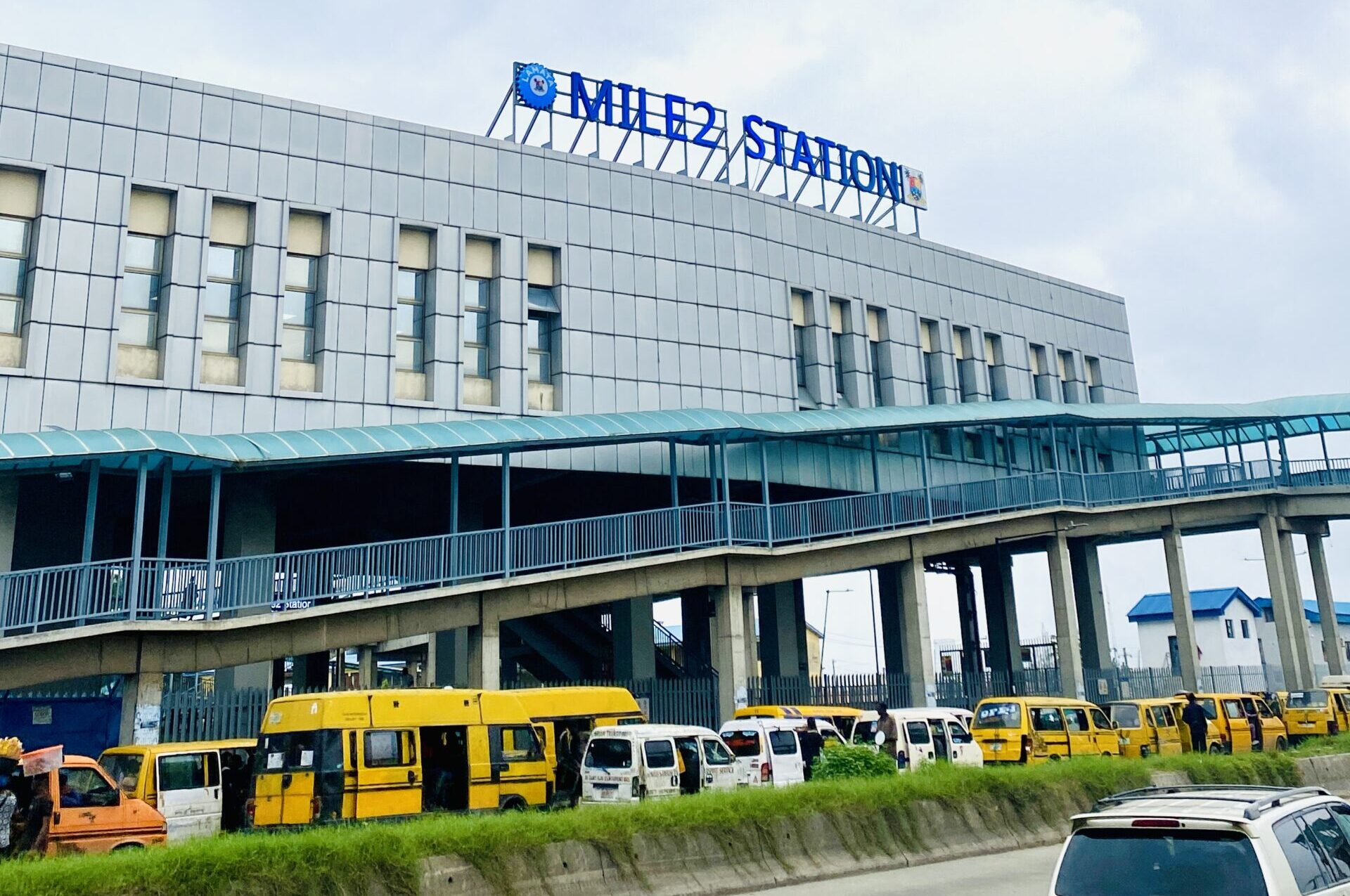I took a Round Trip on the Lagos Blue Line Metro: Here’s what I discovered
On a Wednesday morning, at around 20 minutes past 9 am, I arrived at the Blue Line Mile 2 station to experience my first train ride on Nigeria’s first electric metro rail line.
Crossing the overhead pedestrian bridge, I reached the entrance of the Blue Line terminal complex, ready for my journey.
Inside, I headed to the ticketing booth, where I used my Cowry card, which I also use for the Bus Rapid Transit (BRT) system. The fare for the trip from Mile 2 to Marina station was N750, so I paid N1,500 for my round-trip journey.
With my Cowry card topped up, I proceeded to the fare gate. An official prompted me to place my card on the reader, deducting N750 and allowing me access to the terminal complex.
I was impressed by how neat and organized the Mile 2 terminal looked from the moment I entered until I was ready to board the train. The restroom was particularly clean and well-maintained, reflecting the overall tidiness of the complex.
As the scheduled departure time of 9:30 am approached, I made my way to the boarding platform at Mile 2 station.

Onboard experience: A smooth ride
The blue-coloured, four-car electric train stood on the standard gauge track, doors open and ready for boarding. I entered the second car, finding a seat among passengers who had filled the car to its seating capacity. From my observation, nearly all seats on the China Type B rolling stock were occupied.
The train’s interior was modern and impressive, featuring comfortable seats arranged along the sides to provide ample space and privacy. Large windows filled the car with natural light, creating an airy atmosphere. Digital displays offered real-time travel information and updates on upcoming stops.
At exactly 9:30 am, the doors slid shut with a gentle hiss. The air conditioning system was activated, and the sound system announced our departure from the Mile 2 terminal, heading toward Marina.
The train smoothly accelerated, gliding along the tracks with minimal noise and free from the jerks and jolts typical of other rail travel.
The ride from Mile 2 to Marina offered stunning views of Lagos’s high-rise buildings and bustling urban life. About five minutes after leaving Mile 2, the train briefly stopped at Alaba metro station for approximately 90 seconds, allowing passengers to alight and board.
The train passed vibrant markets and cultural landmarks during brief stops at Iganmu and National Theatre stations. As we neared Marina, passengers enjoyed views of the serene lagoon contrasting beautifully with the urban landscape.
The final approach offered a spectacular view of the waterfront and the towering structures defining Lagos’s coastal charm. The train arrived at Marina metro station twenty-two minutes after departing Mile 2, showcasing the comfort, efficiency, and seamless experience of modern transportation.
Inside Marina station, I grabbed a quick bite at one of the stalls. Although I couldn’t get the cooked rice I requested (LAMATA forbids cooked food within the terminal), I settled for toast and a canned carbonated drink.
Thirty minutes later, the sound system at Marina Station announced the train was ready to journey back to Mile 2. The return trip was as seamless as the first, with a considerable number of seated passengers.
After 22 minutes, including stops at various stations with an average wait time of 90 seconds at each stop, the electric train arrived back at Mile 2 station, 23 minutes after departing Marina.

Voices from the train: Passenger stories and perspectives
During my train ride from Mile 2 to Marina, I struck up a conversation with Reverend Roland Udowa, a regular Blue Line commuter since late 2023.
Reverend Udowa prefers the Blue Line for its comfort and convenience, praising its spacious seating, efficient air conditioning, cleanliness, and pleasant atmosphere.

“I prefer the Blue Line because of the comfort it offers. The ample space, air conditioning, and cleanliness make it a far better option than other public transport on the same route,” he said.
He also highlighted the train’s speed compared to other public transportation, which further solidifies his preference.
However, Reverend Udowa noted a significant challenge: the fare. At N750, it is N250 more than the Danfo buses on the same route. He explained that this extra cost can add up quickly for daily commuters, potentially straining their finances over time.
Additionally, the Wi-Fi on the train, which worked earlier in the year, is no longer functional, he noted, and I confirmed it.
Reverend Udowa also pointed out the lack of a bus network around Blue Line terminals, which he believes contributes to low ridership.
“Many Lagosians cannot use the Blue Line due to the absence of connecting bus services,” he explained.
He added: “Furthermore, the lack of car parks for those who wish to drive to the station is inconvenient for car owners like myself.”
I also spoke to another passenger who took the train from Marina to Mile 2. The young lady, who requested anonymity, shared her thoughts as she alighted from the train.
She has been using the Lagos Blue Line since it opened to the public in the fourth quarter of 2023. She chooses the train for her commute between Mile 2 and Marina because it is more comfortable and significantly faster than other public transportation options.
Unlike Reverend Udowa, she considers the N750 fare fair, citing fluctuating fuel prices and unplanned fare increases by bus operators.
She mentioned that she has not encountered any challenges during her trips on the Lagos Blue Line and described herself as a satisfied passenger. She enthusiastically recommended the electric train for travel between Mile 2 and Marina.

Expert recommendations for scaling the Blue Line
To gain insight into how best to scale the operations of the Blue Line and improve its ridership, I spoke with Tonami Playman, an independent transport researcher specializing in African transit systems. Playman offered four recommendations aimed at achieving these goals.
First, he suggested rerouting existing bus routes to better connect with Blue Line train stations and increasing the number of feeder buses specifically designed to transport passengers to and from the stations.
“Regular and frequent feeder buses would make it more convenient for people to access the train stations, thereby increasing ridership,” he emphasized
Secondly, Playman recommended increasing the frequency of trips on the Blue Line by reducing dwell times and utilizing the train’s acceleration capabilities.
He stressed that improving frequency from the current 2 trains per hour (30-minute intervals) to 10 trains per hour (6-minute intervals) would significantly enhance operational efficiency and attract more passengers.
Thirdly, he advised extending the line to Okokomaiko to increase its usefulness. “The more areas a line connects, the more valuable it becomes,” he stated.
While he admitted that the Lagos State Government is already working on this extension, there are still no plans for the additional trains needed to operate on a longer line.
Finally, Playman suggested adding infill stations on Lagos Island. These are new stations added after a metro line has been built and is operational, typically to fill gaps between existing stations. He advocated for four new infill stations along the line between the National Theatre and the Marina to improve access and convenience for passengers.

Furthermore, Playman argued against private car parks at metro stations due to their high cost and space requirements.
“Private car parking provisions at metro stations is bad practice. It takes up a lot of useful space, while not providing enough capacity to fill the trains,” he explained.
Instead, he recommended focusing on bus transit. “A 12-meter bus can carry 80 passengers, and an 18-meter articulated bus can carry 150. A bus arriving every 10 minutes can deliver 1,500 passengers to the station without needing large car parks,” Playman added.
What you should know about the Blue Line
The Lagos Rail Mass Transit (LRMT) Blue Line is a 27-kilometre urban rail route connecting Marina and Okokomaiko, constructed in phases for efficient execution.
The initial 13-kilometer phase, from Marina to Mile 2, features five stations: Mile 2, Suru-Alaba, Orile Iganmu, National Theatre, and Marina.
Powered by a dedicated power plant, the Blue Line began commercial operations on September 4, 2023, and had transported 583,000 passengers by January 4, 2024. his figure falls significantly short of the state government’s projection of 150,000 daily passengers.
LAMATA’s Managing Director, Engr. Abimbola Akinajo announced that the second phase is expected to be completed by 2027, as reported by Nairametrics. The construction is executed by the China Civil Engineering Construction Corporation (CCECC).
Bottom Line
- My round-trip on the Blue Line from Mile 2 to Marina highlighted the strengths and challenges of Nigeria’s first electric metro rail.
- Despite its comfort, efficiency, and modern features, issues such as fare costs, connectivity, and operational challenges persist.
- Expert recommendations include improving bus routes, increasing train frequency, extending the line, and adding infill stations.
- Addressing these areas could significantly enhance the Blue Line’s success and ridership.
(Nairametrics)


